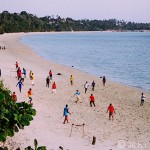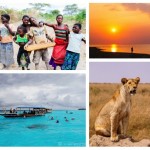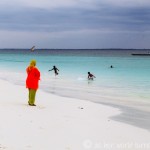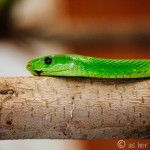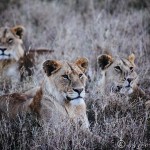After visiting Kilimanjaro, the Serengeti & Ngorongoro Crater, and Zanzibar, the highlights of Tanzania have officially been crossed off my Bucket List. But we still have another two days of driving through the countryside before arriving in our next destination, Malawi. Anticipated points of interest include a valley of baobab trees and special accommodation in a converted farm stable.
We take the ferry from Zanzibar back to Dar Es Salaam, then our guide navigates us towards another ferry (this one only 10 minutes) to a road where we meet back up with our overland truck. Here’s the view stepping off that second ferry, a sea of locals in front of our small tour group:
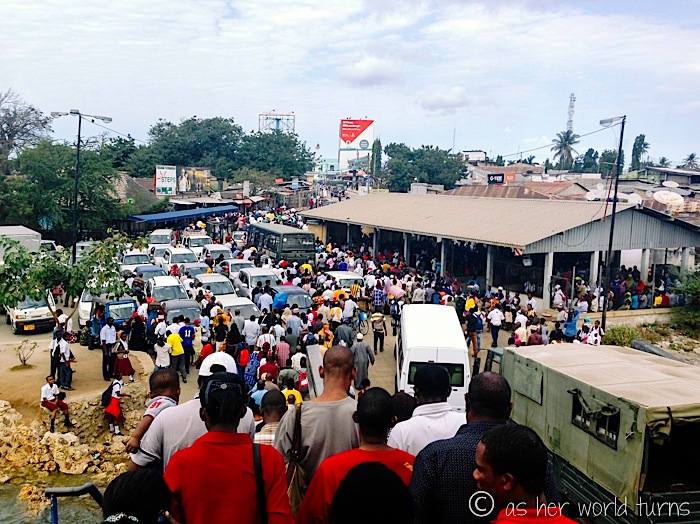
We spend the night at nearby Kipepeo Camp. It’s really a lovely spot on the ocean and if you’re planning your own travel here it’s not a bad place to stay. I hear they have very nice bungalow-style rooms for as little as $25 per night (I don’t think they advertise that price on their website). But since I’m on a camping trip, I skip the room upgrade and camp right next to the ocean.

There’s a security guard manning the gate to the beach at all times, so the campground feels quite safe.
The beach is lovely! I waste no time throwing on a bathing suit and jumping into the water.



Our guide Norman whips up dinner — fried fish with veggies and a starch called ugali (sort of like polenta but local to Tanzania; each country in East Africa has their own staple starch).

There’s a bar with wifi. It’s slow and super expensive to use (a couple of bucks for 200mb) but I’m eager to upload blog posts.

The next day we drive through Mikumi National Park to our campsite. Norman tells us to keep our eyes peeled for wildlife along the way, but we’re not allowed to stop if we see animals because there’s a speed minimum in the park to discourage visitors from doing a spontaneous game drive as they pass through. (They want you to pay a park entrance fee to access other roads for wildlife viewing, even though wildlife is everywhere around here.)

The next morning we have an optional game drive. Since we’ve just come from Serengeti / Ngorongoro I decide to skip it, but those who go end up really loving it. After this, I reply with an enthusiastic YES anytime I am asked about going on an optional game drive. The cost runs about $40, but it’s something I could never see back home (wild animals like lions, giraffes, and elephants in their natural habitat) so in the big picture that price tag is totally reasonable. Every game drive is different and it’s worth a shot to possibly encounter a rare animal, or just enjoy hanging out with the more common ones.
We set off for our next destination, Iringa. It will be our final night in Tanzania.


A particular kind of red onion grows in this area and young men stand by the road in front of buckets piled high with this veggie.

The vendors are tickled that we’re taking photos of them (they must encounter this a few times a week as overland tours pass through) so they start taking photos of us! It’s good-natured; we’re laughing on both sides. I would love to see their photos of us — 17 tourists with big cameras hanging over the side of a truck.

Other times we pass by fruit and veg stands selling products of all colors, an edible rainbow. Each display is artfully arranged and you can tell the vendors take pride in displaying their products. I suspect some of these stands are co-ops where the money collected gets distributed among the group — for example, the red onion guys are very calm about selling their products. Other times the vendors are competitive (“pick me!”) and it’s clear that profits are NOT shared, like in the photo below:


We generally stop for lunch on the side of the road. Our guide and driver look for quiet areas to set up our table and prep lunch without being bothered (or bothering others). Usually somewhere with trees and privacy so that everyone can use the bush toilet. It’s not glamorous but it works.

Our typical lunches include cold cuts and/or tuna, cheese, sliced tomatoes, cucumbers, bread, and tons of condiments. We usually chop up a fresh pineapple or other fruit to cap off the meal. It’s all organized by our guide but everyone pitches in to prep the food and clean up.

Next we pass through a baobab forest valley — an impressive stretch of the famous baobab trees found only in this part of the world (East Africa and Madagascar; there are nine varieties total, each unique to a particular area).

I feel like these trees grew out of Tim Burton’s imagination. Each one has unique characteristics — height, width, position of branches, fullness of branches, wonkiness of branches. They look like a cast of characters: the mom and dad tree next to a little baby tree, the moody teenager tree, the plump matronly tree, the sexy tree, the old grumpy tree. I picture them coming alive at night and talking to each other, a community of baobabs. Anyone want to pitch this to Tim Burton?

Our guide stops on the side of the road so we can take photos. They are massive in person.





Baobab pods have a powdery white substance that according to Wikipedia can be used as a “thickener in jams and gravies, a sweetener for fruit drinks, a tangy flavor addition to hot sauces.” It can be added to sugarcane to aid fermentation in beer making. The fruit pulp and seeds can be eaten fresh and our guide offers them to us — I try one and it tastes sort of chalky.





Another highlight of this region is our accommodation in Iringa — we stay at Kisolanza Farm (also known as The Old Farm House). Its stables have been converted into private rooms. While I’m prepared to camp again tonight (every night, really), I find out last-minute that Nomad Tours has kindly paid for my upgrade to a stable room. How kind of them! I’m thrilled because it will give me a chance to photograph this unique accommodation. I think the rooms cost about $30, and many of them have twin beds so single travelers in our group team up to share one room and split the upgrade cost.
Here’s what the stables look like:


The rooms are so cozy:



This is our group’s communal dining area where we will make breakfast the next morning:

Tonight’s dinner is included in the price of our tour — it’s a catered meal in the Mud Ruins restaurant on-site. This space is really neat.





The food is delicious and we polish off every dish. Some of our generous tour mates offer to buy bottles of wine for the group. We all linger over dinner and drinks while sharing stories and laughter. It’s a really nice night.

After three weeks in Tanzania, our time here has come to an end. What a remarkable country! Recap coming tomorrow.
Thanks to Nomad Tours for discounting this tour in exchange for blogging and photography. Opinions are my own.

